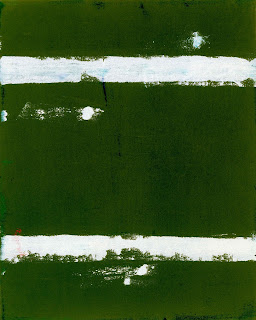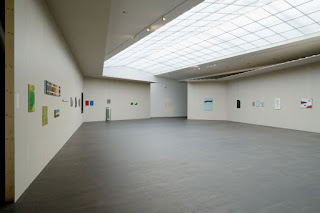I guess it must be the flag of my disposition, out of hopeful
green stuff woven.
-Walt Whitman, Song of Myself 6 (A child said, What is the grass?)
Originally
staged at S.M.A.K, Ghent, now travelling on to co-organizers Pinakothek der
Moderne Sammlung Moderne Kunst, Munich, ‘Oeuvre’ is the largest yet survey of
works by Raoul de Keyser. Around 100 works spanning the 1960’s to the artist’s
death in 2012 are on view.
Though
his reputation may seem long since assured and assimilated, the retrospective
is a reminder that we should never take such things as read. The show
could equally be titled ‘Oeuvre?’- the seemingly banal, functional title masking
an implicit sense of questioning that is entirely appropriate for the artist.
De
Keyser emerged from the 1960’s milieu of Roger Raveel’s New Vision- a distinctive Belgian mixture of pop, daily life,
suburbia- which for him morphed into a tentative abstraction. Early pictures of
sports fields with white lines painted in the grass (seen as wry, mischievous
critiques of the era’s formalism, flaunting the ‘rules’), would recur throughout
a career in which he more or less consistently explored a wavering balance of
abstraction/figuration for the next 40 years.
The
apparently hesitant qualities of early forays into more emphatically abstract
territory are often seen to betray a certain amateurism. Yet it’s a quality he
would, with sophistication, retain and cultivate throughout the decades. For
the ‘Sunday Painter’ connotation is also one of the artist engaged with
pleasure, with delight in the doing (and learning). Or, with the slightly more
desperate notion that one is painting on the Sunday as a refuge from the week.
He doesn’t merely commemorate nor strictly satirize the Good Life in the early
pictures of tents, recreational vehicles, garden hoses, window latches, but
expresses an ambivalence in regard to home comforts, which can equally be about
pleasure and banality, constriction and escape. Gampelaere Surroundings (1967), with its famous close-up of barbed
wire against pastoral field, has a typical bite to it, though the theme is
explored with more subtlety across the years. Window latches later morph,
movingly, into a walking stick (To Walk,
2012). Held up against a provisional suggestion of a country lane rendered in extreme
perspective (expressed with a simple off-centre ‘X’ in wasco crayon), the mobility
aid is both conveyer and barrier/impediment.
Similarly,
the ‘abstracts’ are often somehow wilfully domestic (a kind of precocious ‘back-room’
formalism), carried out in one or two colours, frequently on small stretchers.
There’s a stumbling sense of yearning to understand, to do-well, though in
truth it’s a radical rethink of what ‘doing-well’ might be, in pictorial terms.
This balance of real pleasure with real criticality and real expression is what
separates de Keyser from the cul de sacs of ‘painting’s impossibility’: he
wants to go on being surprised by painting’s life, not its death. And indeed,
Sunday Painting places emphasis on the activity
of painting- pottering around no bad thing.
Except of
course that works of such modest ambition- if they are modest in ambition- could easily drown in a retrospective of
this size.
The
truth is that the work is ambitiously various in terms of atmosphere and
thematic depth- and the current show does a pretty good job of showing that. De
Keyser is a tricky proposition for a big museum as he flaunts institutional
qualities of scale and thematic ‘bigness’, without demonstrably making a fetish
of smallness and intimacy.
The
various rooms are now and then chronological. The first begins appropriately
enough with the ‘60s pictures, alongside the free-standing, stretched linen
‘sculptures’ from that decade (part tent/goalpost, part upturned crash-mat)
gathered fairly close together to give a slightly period feel (or perhaps that
of a gymnasium, a ‘workout’ room). But this is a feint: the show quickly starts
to unravel into thematic groupings, while maintaining a general feeling of progression
and expansion through the decades.
The
potential problems are more to do with the sheer size of the presentation. There is a
valid question of whether a museum-scale retrospective is the best way to
experience de Keyser- frequently domestic in size if not ambition.
The
paintings are often best encountered when hung to the rhythm of less neutral
rooms, as they were when spread sporadically throughout the converted residential
interior of Edinburgh’s Inverleith House in 2015 (see below). The present show similarly
comes to life most when the white cube is relaxed. Architects Robbrecht and and
Daem- who have created several exhibition spaces for the artist since Documenta
IX in 1992- have built ‘walls’ within the walls of the central room: held up by
MDF posts and made of builder’s gyprock, their papery, flecked and pulped
surface vibrates with the paintings, letting his whites particularly sing. The
installation here is utterly sympathetic to the painter’s sense of utilitarian
construction and play (the paintings sit in a subtle grid of joints and screws,
mirroring his frequent exposal or acknowledgment of the stretcher bar). The
room, entered in Ghent through a separate door and with works darting from year
to year, is a revelation- elastically hung with de Keyser’s precise sense of élan.
De
Keyser spent a career experimenting with ‘hangs’; a constant process of staging
and photographing faux-exhibitions in his studio; leaning paintings against
walls, hanging them with blunt hook devices; putting them outside or in trees. Indeed,
the question of ‘Oeuvre?’- what it might constitute, its fluidity, how
individual works create ripples and eddies in the larger body which can support
and extend those works in turn- seems to have been central to his project.
These
questions, pertinent for any artist, are especially invited by de Keyser’s
particularly self-sustaining practice. New works are created from off-cuts, or
based on the debris left by lino-cutting, or are preoccupied with example and ‘iteration’
generally. I suspect certain paintings may have been made as gap-fillers in his
studio hangs. Not out of formula, but a push to expand formally, spurned on by
the need for something red, or longer, or more emphatically tonal, say. These
studio arrangements, obsessively documented by the artist (and reproduced in
the comprehensive catalogue),
see him looking not for total cohesion but locating opportunities for expansion.
Notions
of expansion and collection, of (sometimes eccentric) growth are reinforced by
frequent pictures that allude (however obliquely) to water, to trees. Shore from 2005 is disconcertingly
illusionistic despite/because of it’s red border, while the broken white lines
of his sports pitches are cut down to become birches. Monkey-puzzle trees
become all-over abstraction, or gestural marks against steamed-up windows (as in
1989’s November). There can be
references to their much older Low Countries tradition- as in the abstracted
windmill of Sinking (Piet)- reflective
water, flooded fields. The deceptively simple conveyance of silvery outdoor
daylight, or its filtering through shuttered interiors, recalls that of David Teniers
the Younger.
Highly
frequent images of shutters, doors, windows, blinds- devices which allow in the
light, admitting one to see out but not in- speak of the work’s air of privacy.
Even the monkey-puzzle tree, with its sense of structural confusion, is
deliberately planted as a barrier, a screen. These images perhaps speak of our
position as viewers peering through the cracks, and the dangers of getting the
wrong end of the stick, being critical busybodies. De Keyser, particularly in
his later years, is something like an old man gleefully placing questionable
objects on his windowsill to delight or bamboozle the neighbours. Yet through
time we get to know him.
‘Oeuvre’
allows itself to be summed up in its last room via a huddled grouping of small
paintings which de Keyser was working with at the time of his death. They have
subsequently been shown, and reproduced in book-form,
under the title of ‘The Last Wall’ (though the exact selection has shifted
slightly over the years).
These
particularly small works ride currents that run throughout the oeuvre- given
poignancy and testimonial status by their biographical significance. And yet
they are not summations but starting points. They can be graphic, or impasto,
or thinly washed in subtly new ways. Forms can be yet more reduced, or more
representational. They are more abject and unlovely than anything which came
before- but are buoyed by the memory of it all. And still his illusionism is
healthy. Seascape is a rag of canvas
wrapped around the middle of a stretcher, hardly meeting the edges; but these
edges become the sides of huts, unpainted canvas the sand; a single gradient of
white sky breaks off to make waves.
The
abiding image of ‘Oeuvre’, and the real summation of his career is a little
painting titled Robben 1. Swirly
lines make a rudimentary frame for a newspaper clipping of a footballer, laying
down on the pitch like a star gazer (a rare photo-collaged element).
Wonderfully scrappy though the match has been, the player falls back, surveying
the world from within his chosen arena, delighted by it all.
...
NB. This reviewer realizes that Arjen Robben, the Dutch player pictured in Robben 1, is in reality less than 'delighted'- having just suffered many near-misses in a disastrous losing match against Denmark at Euro 2012. De Keyser- originally a sports journalist -would surely have been drawn to the ambiguity of the image, its apparent carefree reverie in a moment of personal despondency. The small painting muses on the perils of missing the target, being off the mark, on the chances of luck, skill and effort coming into alignment, of opening one's self up to potential failure. Almost a secular icon, Robben 1 is about being involved in and alive to the complexities of art and life, to the field of human endeavor.
.





























